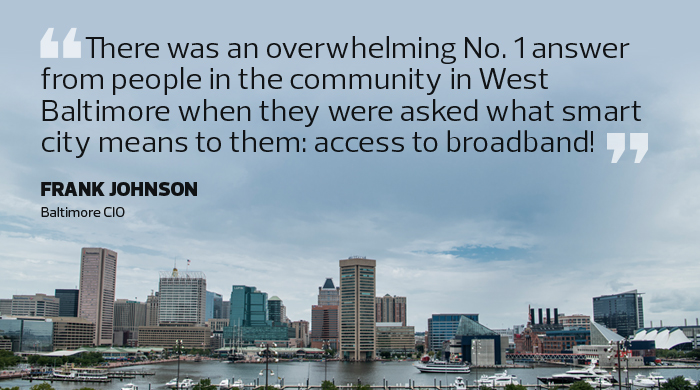Q&A: Baltimore CIO Frank Johnson Lays Out a Digital Transformation Vision
After a successful career at Intel, Frank Johnson assumed new responsibilities as CIO of Baltimore last year. Mayor Catherine Pugh has made digital transformation a top priority for her city, and Johnson shares her commitment.
In an exclusive interview with StateTech, Johnson discusses his goals, including modernizing Baltimore’s human resources and finance systems, upgrading public safety tech, innovating with smart city concepts and building a first-class organization capable of making everything happen.
STATETECH: Your first year has been eventful, and you’re getting a lot done. What are your biggest priorities right now?
JOHNSON: For the first time in the history of the city, we wrote a strategic IT plan. It’s an aspirational document and very visionary with a lot more detail to follow, but it is absolutely a starting point. When you read through that strategic plan, it screams, “We need a lot of everything, starting with people and investment.” The plan embraces more cloud, more cyber, more enterprise resource planning, more data, more smart city and more partnerships. My personal passion is organizational development in people, and you can’t digitally transform anything without a 21st- century organization.
STATETECH: The mayor herself has called your IT systems outdated. Where do you start to update them?
JOHNSON: We’re fixing the fundamental foundation, the data networking and making certain critical systems more resilient. In other words, making them more fully tolerant. That’s stuff you don’t see, but it helps make the city operate efficiently.
We’re moving to the cloud with a handful of partners as quickly as we can. We are seeking a more elastic capability so that we can ingest more data. When we do more city projects, we are going to have more data to consume.
Also, the HR and finance systems here in the city are woefully outdated, and big chunks of them are still on a mainframe. Running a modern cloud-based Software as a Service offering for HR and finance is absolutely part of the plan, and that project is moving forward. We’re also planning to improve and update all of the current public safety tech systems.
Last but not least, we’re planning to be a smart city. How do we do it? With whom? What are the investment models? What are the partnerships? We’re working through that with the city’s first-ever Smart City Council. It’s made up of partners around the community and civic leaders to talk about the challenges. We have a few projects in flight, but how do we scale them and make them bigger as we modernize?
STATETECH: What specifically might be priorities for the smart city initiatives in Baltimore?
JOHNSON: Desire and demand are high. We’re working on a smart city project in West Baltimore with the University of Maryland. The university asked the community what “smart city” meant to them. That’s key to the process of deciding what we’re going to do first and when. The results of the survey came back, and there was an overwhelming No. 1 answer from people in the community in West Baltimore when they were asked what smart city means to them: access to broadband!
We’re thinking smart cars, smart lighting, smart traffic, smart garbage cans, and the citizens listed their first priority in smart city as better broadband access or access for the first time ever. That’s why our broadband fiber strategy and plan is so important. We know that it’s going to be a very key enabler, not only in smart city but in citizen engagement — all of those things that you absolutely have to do to close the digital divide.

STATETECH: You came from the private sector after spending your career in the Baltimore area. Were you able to hit the ground running because of your background with Intel and your familiarity with the region?
JOHNSON: I ran enterprise sales for Intel for many years, and my job was to interface with multiple industries — government, retail, manufacturing, energy, financial services and others. In every industry, everybody would admire the fact that they were unique or different and spoke a different language than people in another industry.
Throughout my career, I toured many data centers, and I talked to many leaders and crossed many industries, and I saw more similarities across industries than I saw differences. When I left corporate life to work in Baltimore City, I came with the preconceived notion that it’s different. But people are people. Baltimore City is just like Bank of America, it’s just like Jeep and it’s just like Procter & Gamble. It’s trying to solve very similar problems using very similar market capabilities.
Anything is possible in life with leadership and investment. I am here primarily because of the vision of the current mayor of Baltimore, a tireless, relentless, passionate, committed leader who offered me the opportunity to come to work with her to help digitally transform an entire community. Again, we’re not here just to fix the IT in city government, but to digitally transform this entire community — a community right in my own backyard where I’ve lived for the last 35 years.









